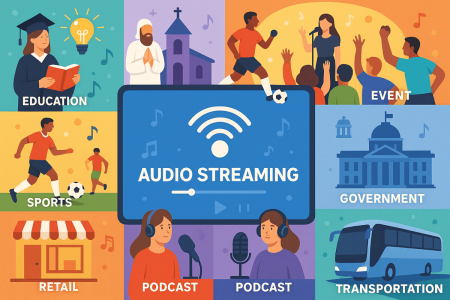Who Uses Audio Streaming? A Look at the Diverse Industries Powering Their Voice Online
Audio streaming is no longer just for music lovers or big-name radio stations. Today, organizations across a wide range of industries use streaming technology to connect with audiences in real-time, no matter where they are. From schools and houses of worship to public safety agencies and fitness trainers, streaming audio is an essential tool for communication, outreach, and engagement.
Here’s a breakdown of the many sectors actively using audio streaming and how they’re leveraging it:
1. Schools & Universities
Educational institutions stream live sports games, graduation ceremonies, lectures, and even school board meetings. It’s a powerful way to engage families, alumni, and students who can’t attend in person.
2. Churches & Religious Organizations
Many churches stream Sunday services, prayer groups, funerals, and religious holidays to reach homebound members or people across the globe. Streaming allows them to spread their message without needing expensive TV setups.
3. Online Radio Stations
Internet radio stations are one of the most obvious users. They broadcast music, talk shows, interviews, and niche content to global audiences. Streaming makes it affordable to run a station from virtually anywhere.
4. Event Planners & Venues
Concerts, festivals, conferences, and town halls benefit from streaming by offering real-time audio feeds to attendees online, especially when in-person attendance is limited or restricted.
5. Sports Leagues & Amateur Teams
Local leagues, amateur sports clubs, and youth teams stream live commentary and play-by-play audio of games to fans and family. It’s ideal for minor leagues that can’t afford video production.
6. Government Agencies
Municipal and public safety departments stream council meetings, emergency broadcasts, and community updates to keep citizens informed in a timely and accessible way.
7. Fitness Instructors & Gyms
Personal trainers and gyms stream live workout sessions, meditation audio, or motivational segments for remote clients, ideal for fitness brands expanding online.
8. Podcasters & Talk Show Hosts
Many podcasters repurpose their content as live streams to build a real-time connection with their audience. It also gives them flexibility to reach listeners across multiple platforms.
9. Retail Stores & Restaurants
Background music and promotional messages are streamed in-store or on digital channels to enhance the customer experience. Some businesses even stream their own branded audio content.
10. Transportation & Travel Services
Cruise lines, tour operators, and even public transit systems use streaming for announcements, entertainment, and guided tours that travelers can access from mobile devices.
11. Political Campaigns & Advocacy Groups
Live speeches, town halls, and rally coverage are often streamed to help engage supporters and voters in real time. Audio streaming is more lightweight than video and can reach areas with low bandwidth.
12. Healthcare Providers
Hospitals and health networks stream wellness talks, live Q&As with doctors, or support groups, giving patients and caregivers easier access to important information.
13. Language Schools & Tutors
Streaming allows teachers to deliver real-time language lessons or practice sessions with students across the world, particularly effective for speaking and listening exercises.
14. Gaming Communities
Gamers stream live audio commentary, team communication, and in-game events, offering a low-lag solution that doesn’t require heavy video bandwidth.
15. Corporate Internal Communications
Companies use private streams for employee updates, CEO town halls, or team meetings, especially when they have remote or distributed workforces.
Why These Industries Choose Audio Over Video
While video has its place, audio streaming remains popular because it’s:
- More bandwidth-friendly: Listeners can tune in even with slow internet.
- Mobile-first: Works perfectly on the go, even when the screen is off.
- Lower production cost: No need for expensive video equipment or editing.
- Easier to scale: Stream to 10 or 10,000 listeners with minimal infrastructure.
Final Thoughts
Audio streaming isn’t just for traditional radio anymore. It’s a versatile, cost-effective solution used by schools, churches, government offices, startups, and more. If your organization has a message to share, chances are audio streaming can help you reach a wider audience live, clearly, and without limits.
Interested in starting your audio stream?
Explore affordable SHOUTcast and Icecast plans tailored to your needs at ShoutCheap.com.
FAQ
Industries such as education, healthcare, retail, and government agencies utilize audio streaming to connect with their audiences.
Audio streaming allows businesses to reach a broader audience, engage listeners in real-time, and provide content on-demand.
